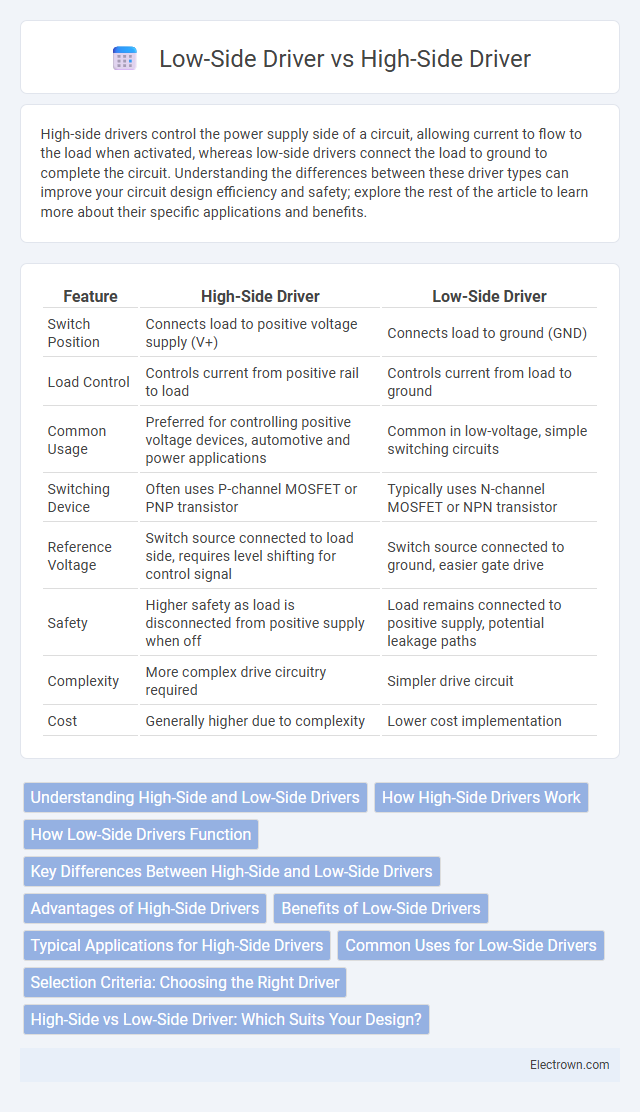High-side drivers control the power supply side of a circuit, allowing current to flow to the load when activated, whereas low-side drivers connect the load to ground to complete the circuit. Understanding the differences between these driver types can improve your circuit design efficiency and safety; explore the rest of the article to learn more about their specific applications and benefits.
Table of Comparison
| Feature | High-Side Driver | Low-Side Driver |
|---|---|---|
| Switch Position | Connects load to positive voltage supply (V+) | Connects load to ground (GND) |
| Load Control | Controls current from positive rail to load | Controls current from load to ground |
| Common Usage | Preferred for controlling positive voltage devices, automotive and power applications | Common in low-voltage, simple switching circuits |
| Switching Device | Often uses P-channel MOSFET or PNP transistor | Typically uses N-channel MOSFET or NPN transistor |
| Reference Voltage | Switch source connected to load side, requires level shifting for control signal | Switch source connected to ground, easier gate drive |
| Safety | Higher safety as load is disconnected from positive supply when off | Load remains connected to positive supply, potential leakage paths |
| Complexity | More complex drive circuitry required | Simpler drive circuit |
| Cost | Generally higher due to complexity | Lower cost implementation |
Understanding High-Side and Low-Side Drivers
High-side drivers switch the positive voltage supply to the load, making them ideal for controlling devices connected to the positive rail, while low-side drivers connect the load to ground, switching the negative side of the circuit. Understanding the difference between high-side and low-side drivers is crucial for selecting appropriate components in power electronics and motor control applications. High-side drivers often require level shifting and specialized circuitry to handle the voltage, whereas low-side drivers are simpler but limited by ground referencing.
How High-Side Drivers Work
High-side drivers control the power supply to a load by connecting it to the positive voltage rail, allowing current to flow from the source to the load when activated. They often use a P-channel MOSFET or a high-side switch configuration with a bootstrap circuit to provide the necessary gate voltage for switching. High-side drivers are essential in applications requiring load switching at the positive terminal, ensuring safe and efficient power control in automotive, industrial, and consumer electronics systems.
How Low-Side Drivers Function
Low-side drivers function by connecting the load to the ground, allowing current to flow through the device when the driver switches the connection to the ground side. This method simplifies circuit design and often reduces component cost, making it ideal for applications requiring straightforward load control. Your choice of low-side driver ensures efficient switching for devices grounded in a common reference point.
Key Differences Between High-Side and Low-Side Drivers
High-side drivers connect the load to the positive voltage supply, allowing control by switching the voltage source, while low-side drivers switch the connection to ground. High-side drivers offer better safety in certain applications by preventing the load from being energized unintentionally, whereas low-side drivers are simpler and more cost-effective but can introduce ground reference issues. Your choice depends on the specific circuit requirements, such as load type, control complexity, and isolation needs.
Advantages of High-Side Drivers
High-side drivers offer superior protection by connecting the load to the positive supply voltage, preventing accidental grounding and reducing the risk of short circuits. They enable easier control of common ground in complex circuits, improving system stability and reducing noise interference. High-side drivers also enhance safety in automotive and industrial applications by allowing better isolation and more reliable current sensing.
Benefits of Low-Side Drivers
Low-side drivers offer simpler circuit design and easier implementation due to their direct grounding control, reducing complexity in load switching. They provide cost-effective solutions with fewer components required for switching loads on the negative side, enhancing reliability in various applications. Low-side drivers improve system stability by minimizing the risk of voltage spikes and electromagnetic interference during switching operations.
Typical Applications for High-Side Drivers
High-side drivers are commonly used in automotive electronics for switching the positive supply voltage to loads such as fuel injectors, sensors, and lighting systems. Industrial automation systems employ high-side drivers to control actuators and motors by supplying power from the positive rail, ensuring load protection and efficient operation. These drivers are essential in battery-powered devices, providing safe and reliable switching of the positive voltage line while minimizing ground interference.
Common Uses for Low-Side Drivers
Low-side drivers are commonly used in applications requiring switching of the negative side of the load, such as controlling ground-referenced devices like LEDs, motors, and relays. They are favored in automotive and industrial control systems due to their simplicity, cost-effectiveness, and ease of implementation with NPN transistors or N-channel MOSFETs. These drivers efficiently manage loads where the power supply remains constant, enabling reliable switching by grounding the circuit.
Selection Criteria: Choosing the Right Driver
Selecting the right driver depends on the application's voltage, load type, and switching speed requirements. High-side drivers are ideal for sourcing current to the load, offering protection against short circuits and reverse polarity, while low-side drivers excel at grounding loads and tend to be simpler and more cost-effective. Evaluating your system's power supply configuration and safety needs ensures optimal performance and reliability in your circuit design.
High-Side vs Low-Side Driver: Which Suits Your Design?
High-side drivers switch the positive voltage supply to the load, offering better protection against ground faults and ideal for sourcing current applications, while low-side drivers connect the load to ground, simplifying circuit design and lowering cost. High-side drivers are suitable for designs requiring load-side switching and enhanced safety, commonly used in automotive and industrial systems, whereas low-side drivers fit applications prioritizing ease of implementation and reduced component count. Selecting between high-side and low-side drivers depends on the load type, required switching configuration, and specific protection needs within your circuit design.
High-Side vs Low-Side Driver Infographic

 electrown.com
electrown.com